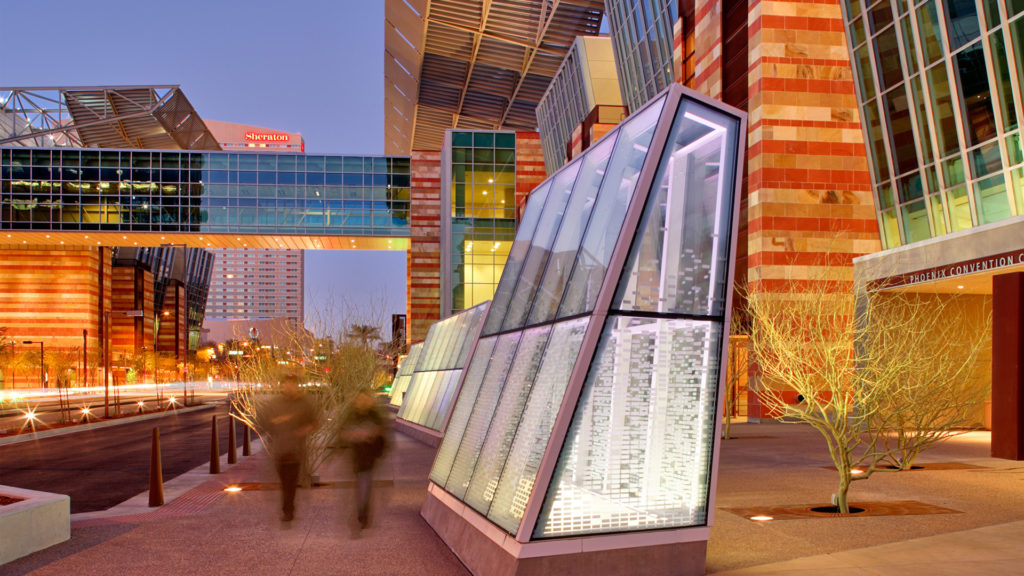Planning for Flexibility: The Phoenix Convention Center and Super Bowl XLIX
January 28, 2015 / Michael Lockwood
-
Categories
Tags
Phoenix Convention Center opened in 1972 – at a time when the region looked much different than it does today. Development was sparse at that time and large public buildings – like the convention center and University of Phoenix Stadium – had not yet entered the landscape and reshaped how the area was viewed. The development and vibrancy that has now come to define the region was still decades away.
Now, more than 40 years after the building initially opened, the Super Bowl and downtown festival experience that accompanies it will descend on the Phoenix Area for the third time in less than 20 years, a sign of the city’s evolution. And the Phoenix area is going to look significantly different to visitors than it did in 2008, when the last Super Bowl was hosted there. The city has invested more than $4 billion in public infrastructure since then, as my colleague Todd Barnes discusses in his latest blog… and it certainly shows. Part of this investment has been the renovation and expansion of the Phoenix Convention Center, which designed by Populous and completed in 2009.The convention center expansion has been an integral part of pioneering a new experience for convention attendees and visitors, while shaping new storylines about the city and region. The city has come to be seen as a central hub for both business and leisure in the past few years, known for its hospitality offerings, scenic views and accessibility. Phoenix Convention Center reflects this and has been an integral tool for the city in sharing this message. Located in the heart of the urban core, the building pushed the boundaries of the convention center experience, incorporating non-traditional outdoor meeting spaces, thoughtful flexibility and configuration of meeting spaces and a dynamic pedestrian experience that integrates the city’s hospitality and leisure offerings to the building’s front doors. The design combined the city’s existing assets with their vision of who they wanted to be, and Super Bowl XLIX is an opportunity to shine a light on this holistic story about the region.

The Phoenix Convention Center will serve as the core of a 12-block downtown festival and will host the NFL Experience, hundreds of media and other auxiliary events. The building was designed with this flexibility and adaptability in mind, allowing event planners to capitalize on its prime location downtown. Part of what makes the building an ideal activity hub for the festival is the 360 degree access we incorporated into the planning of the facility – including pedestrian entrances on all four sides – connecting the building to its surrounding development and making it a conduit of activity year-round. The configuration of the building also creates the flexibility needed to accommodate an array of events, with nearly two million square feet of flexible meeting and event space. This is undoubtedly an advantage to our event planning team when coordinating a complex, multi-day, multi-faceted event like the Super Bowl.
Our approach to designing the experience at the convention center directly corresponds with how we designed University of Phoenix Stadium. We created, in both cases, buildings that are iconic assets to the region that can also transform to accommodate the diverse needs of fans, visitors and customers when used simultaneously for large destination-wide events. It is imperative that cities consider potential multi-facility event opportunities when planning and designing convention centers, stadiums and other major components of event infrastructure to maximize these facilities’ revenue generation opportunities. Mega-events such as The Super Bowl, Comi-con and the Olympics are examples of large scale events that utilize many facility types spread across a wide geographical area to integrate the guest experience with the destination experience in a memorable way. However, this same strategic planning should be considered by cities of any scale to ensure a holistic and authentic guest experience while accommodating events and festivals of any size.
These two facilities, The Phoenix Convention Center and The University of Phoenix Stadium are integral to who Phoenix is… and to the experience that all visitors have while visiting this great destination. Our design approach to both facilities creates consistency of experience and helps shape the memories formed for everyone who sees, enters or engages with these buildings. Our charge as designers is to connect the dots for visitors and residents with these core components of experience infrastructure, telling a compelling and memorable story from building to building, event to event. Ultimately, we’re weaving together a larger, more powerful story about a city with each building we design and event we plan – and Phoenix has a great story to tell.
